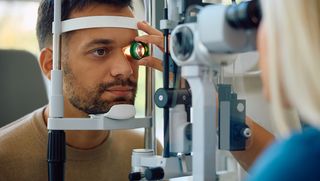Keratoconus
Learn about the symptoms, causes, and treatment options for keratoconus.

Summary
Keratoconus is an eye condition which affects the cornea and its shape, causing changes in your vision. Read more to learn more about how keratoconus presents and the treatment options available.
Keratoconus (ker-a-toe-KOH-nus) is a condition that affects the cornea – the clear, dome-shaped front layer of your eye. In keratoconus, the cornea (normally a rounded shape) gradually thins and bulges outward into a cone shape. The structural change in the shape of the cornea disrupts how light enters the eye, causing distorted vision. Keratoconus most commonly begins in the teenage years or early adulthood.
The prevalence of keratoconus in Australia has previously been estimated at around one in 2000 people. An Australian study by Chan et al from 2020 significantly expanded the understanding of the condition, and found that approximately one in 84 people aged twenty had Keratoconus. The study used a large-scale screening of university students to identify undiagnosed cases, pointing out that many people may have the condition without realising it – especially in its early stages when symptoms can be mild or overlooked. These findings emphasise the need for frequent eye exams, and early intervention to reduce or prevent progression of the condition.
What is it? Keratoconus (ker-a-toe-KOH-nus) is a condition that affects the cornea – the clear, dome-shaped front layer of your eye. In keratoconus, the cornea (normally a rounded shape) gradually thins and bulges outward into a cone shape. The structural change in the shape of the cornea disrupts how light enters the eye, causing distorted vision. Keratoconus most commonly begins in the teenage years or early adulthood.
The prevalence of keratoconus in Australia has previously been estimated at around one in 2000 people. An Australian study by Chan et al from 2020 significantly expanded the understanding of the condition, and found that approximately one in 84 people aged twenty had Keratoconus. The study used a large-scale screening of university students to identify undiagnosed cases, pointing out that many people may have the condition without realising it – especially in its early stages when symptoms can be mild or overlooked. These findings emphasise the need for frequent eye exams, and early intervention to reduce or prevent progression of the condition.
Symptoms: Keratoconus affects each person differently, but common symptoms include:
- Blurred or distorted vision.
- Increased sensitivity to light and glare.
- Difficulty seeing at night.
- Frequent changes in eyeglass prescriptions.
These symptoms can vary depending on how advanced the condition is.
Advanced keratoconus
Keratoconus does not typically cause complete blindness, but it can lead to significant low vision if left untreated. As the cornea becomes thinner and more irregular in shape, it distorts vision, making it difficult to perform everyday tasks like reading, driving, or recognising faces. Initially glasses and contact lenses can improve vision to satisfactory levels however as the disease progresses and the corneal distortion increases this may no longer be the case.
In advanced cases, corneal scarring or extreme thinning can severely impair vision, potentially requiring a corneal transplant. However, with early diagnosis and modern treatments like corneal cross-linking, the progression can often be slowed or halted, preserving functional vision.
Causes and risk factors: The exact cause of keratoconus is unknown, but factors that may contribute include:
- Genetics: It sometimes runs in families.
- Eye rubbing: Frequent and vigorous eye rubbing can damage the fibres of the cornea and can trigger or aggravate progressive keratoconus. Dry or itchy eyes should be treated medically; avoid rubbing your eyes
- Existing conditions: Keratoconus is more common in some people with other conditions including Down syndrome, allergies, hay fever, asthma, eczema, and food allergies.
Diagnosis: Children at higher risk for keratoconus – such as those with a family history of the condition, children who frequently rub their eyes, or have an existing diagnosis of Down syndrome or allergies should have their eyes checked by an optometrist or ophthalmologist without delay. Regular eye exams every one to two years can help detect keratoconus or other vision conditions early.
Adults should also undergo regular eye exams, especially if they experience symptoms like blurred vision, frequent prescription changes, or sensitivity to light. Early detection is key, as treatments like corneal cross-linking (detailed below) are most effective in slowing the progression of keratoconus when diagnosed in its initial stages.
When diagnosing keratoconus, your eye care professional will check your vision, corneal shape, and your general eye health.
Treatment: Treatment depends on the severity of the condition and may include:
- Eyeglasses or contact lenses: In the early stages, glasses or soft contact lenses can correct vision. As the condition progresses, rigid gas-permeable or hybrid contact lenses may be needed.
- Corneal cross-linking (CXL): This treatment strengthens the cornea to stop or slow the progression of keratoconus. It involves applying riboflavin (vitamin B2) drops to the eye and activating them with UV light.
- Surgery: In advanced cases, procedures like corneal transplants or inserting corneal implants may be necessary.
If you have keratoconus and low vision, there are tools and strategies that can help you adapt:
- Low vision aids: Magnifiers, specialised glasses, or screen-reading software can help you perform daily tasks
- Lighting: Use bright, non-glare lighting to improve visibility at home or work.
- Regular eye exams: Monitoring your condition ensures you get the right treatment at the right time.
- Support networks: Joining a support group for people with low vision can provide helpful tips and emotional encouragement.
- Protecting your eyes: Avoid eye rubbing. Wear UV-protective sunglasses to shield your eyes from harmful rays. Manage allergies to reduce irritation.
Regular eye exams are essential for early detection and treatment of corneal conditions and to preserve vision.
For more information
Keratoconus Australia provides support to people with keratoconus and their families. Visit their website for more information.
Always speak to your doctor or eye care professional for expert advice and guidance on your eye health.
Did you find this article helpful?
Share your thoughts and help us make our resources better for everyone.
Enjoying the content?
Start building your profile to access personalised support, resources, and tools tailored to your eye health journey.
